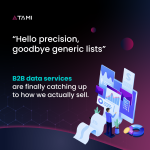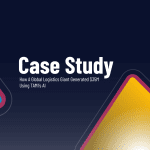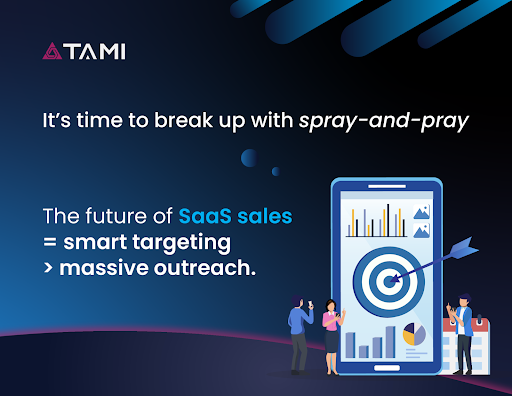
The Future of B2B Data Services is Real-Time and Role-Specific
05/11/2025
Competitor Analysis
15/11/2025Artificial intelligence has already transformed how sales teams find, qualify, and connect with leads. But 2026 will mark a new chapter, one where AI for sales prospecting becomes deeply embedded across every stage of the funnel.
If you’re still relying on outdated databases or manual research, this is the year to rethink how your sales operation uses AI. Let’s break down the trends that will shape how top-performing teams prospect smarter, not harder.
1. AI-led prospect research replaces manual data gathering
Manual prospecting still eats up 40% of a sales rep’s week, according to HubSpot’s 2025 Sales Report. In 2026, that time sink is vanishing fast. Sales teams are moving toward AI-driven research tools that identify ideal customers, scan web data in real time, and validate contacts automatically.
With platforms like TAMI, teams already access fresh, verified emails and phone numbers, see what technologies a company uses, and enrich CRM records with contextual firmographics.
The next wave of AI prospecting will automate the full research cycle, from lead sourcing to CRM enrichment, while maintaining data accuracy rates above 95%.
2. Predictive intent data will guide outreach
AI for sales prospecting is getting better at reading signals that indicate buyer intent. In 2026, predictive intent scoring will become a standard feature in sales automation. By analyzing website activity, hiring trends, funding rounds, and product adoption shifts, AI models will flag when a prospect is likely preparing to buy.
Tools like TAMI already leverage web crawling and real-time data scanning to reveal such indicators. When integrated into CRMs, this data helps reps prioritize high-value accounts, reducing wasted outreach and boosting response rates.
3. CRM enrichment AI will eliminate data decay
Data decays fast, up to 30% annually. That’s why CRM enrichment AI is no longer optional. The next phase of sales automation focuses on keeping pipelines accurate without human intervention.
TAMI, for example, monitors job changes, validates email deliverability, and updates missing LinkedIn profiles automatically.
In 2026, expect AI to go beyond updating contact fields, as it will interpret data patterns to recommend when to re-engage dormant leads or flag accounts with shifting buying committees.

4. Personalized B2B targeting with AI
Generic outreach is dying. By 2026, AI for sales prospecting will mean generating highly personalized prospect lists based on behavior, firmographics, and even the technologies a company uses.
For instance, TAMI’s AI maps over 7 million eCommerce merchants globally, analyzing their payment providers, shipping partners, and tech stacks.
That level of segmentation lets sales teams craft tailored messages that resonate with a specific vertical, region, or even competitor’s customer base.
5. Conversational AI will mature beyond chatbots
Most sales teams already use chatbots for qualification, but the next generation of conversational AI will manage more complex, context-aware interactions. Expect AI assistants that can recall previous conversations, answer pricing questions, and schedule calls without scripts.
What’s changing in 2026 is the integration: these systems will pull from enriched CRM data, like the kind TAMI provides, to personalize every message dynamically. That means your chatbot won’t just qualify a lead, but it will sound like your top-performing SDR as well.
6. Compliance and ethical AI become a selling point
As privacy regulations tighten, AI vendors will be judged on compliance as much as capability. Sales teams will prioritize AI prospecting tools that respect GDPR, verify contact data ethically, and maintain email deliverability standards.
TAMI, for instance, guarantees a bounce rate under 5% by validating all contact data directly to the inbox. This kind of reliability protects both brand reputation and sender score; a competitive advantage that’s becoming central to enterprise sales strategies.
What this means for your 2026 sales strategy
The smartest sales teams won’t be the ones investing most in AI for sales prospecting, but the ones connecting it all. CRM enrichment, predictive insights, and automated outreach need to work together, powered by real-time, verified data.
If you’re planning your 2026 sales tech stack, consider how TAMI can be your single source of truth for accurate contact data, CRM alerts, and market intelligence. That’s how teams build more revenue with fewer manual steps.
Your 2026 action plan:
- Audit your CRM to identify gaps, outdated contacts, and missing fields that slow down prospecting.
- Integrate AI enrichment tools like TAMI to automatically refresh and validate contact data.
- Use predictive insights to prioritize leads showing buying intent or growth signals.
- Automate outreach with data-driven segmentation instead of generic mass emailing.
- Monitor CRM alerts to act when prospects change jobs, join competitors, or expand operations.
- Review performance monthly to refine targeting and ensure your data stays accurate and compliant.
The difference between hitting quota and exceeding it in 2026 will come down to how effectively you connect your systems, not how many tools you add.
Final thoughts
The next wave of AI for sales prospecting will reward precision over volume. Teams that combine enriched data, automation, and intent-driven insights will consistently outperform competitors who rely on guesswork.
If your goal for 2026 is to scale smarter and shorten the path to revenue, start with the foundation that powers every great sales strategy: accurate, real-time data.
Start your free TAMI trial today and see how AI-driven prospecting can transform your pipeline.









